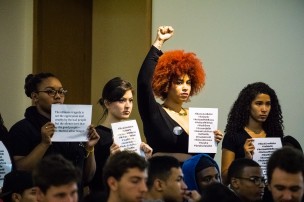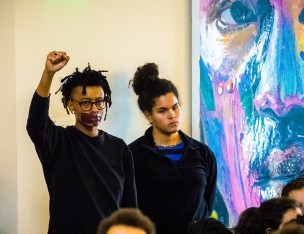On Nov. 12, students and faculty participated in a Blackout event in support of students of color at the University of Missouri.
Silence overtook the usually-loud side of Usdan Marketplace on Thursday, Nov. 12, as students dressed in all black stood together in solidarity with protests against racial injustice at the University of Missouri, Yale University, and a number of other college campuses across the country.
Over the last few months, the University of Missouri (Mizzou) has experienced a series of racist incidents on campus, to which many students and faculty felt the administration did not sufficiently respond. Jonathan Butler, a graduate student at Mizzou, began a hunger strike on Monday, Nov. 2 in protest of University of Missouri System president Tim Wolfe, pledging to continue his strike until Wolfe resigned.
On Saturday, Nov. 7, a large portion of the school’s football team, backed by their coaches, put their support behind Butler and announced they would refuse to participate in any football activities until Wolfe resigned. The next day, he officially stepped down.
Online threats and rumors of violence—including terror threats against students of color at Mizzou—led the school on Wednesday, Nov. 11 to increase its security and some teachers to cancel class altogether.
Following these threats, students from various universities began to show their support on Facebook and Twitter.
“To the black students and other students of color at Mizzou, I and other student allies at Wesleyan University, stand with you in solidarity. To those who would threaten your safety, we are watching. #ConcernedStudent1950 #InSolidarityWithMizzou,” read a number of Wesleyan students’ Facebook statuses.
The first hashtag, #ConcernedStudent1950, refers to the University of Missouri student activist group spearheading the call for change; the year 1950 pays homage to the year the first black students were enrolled at the school.
At Wesleyan, students created a Facebook event, “Usdan Blackout: Black Collegiate Solidarity,” with the intention of taking immediate action on campus.
The event listed three calls to action. It asked students and faculty to wear all black on Thursday. It also announced a Usdan takeover that day between 11 a.m. and 1 p.m. Finally, at 12:30 p.m., students would be present on the loud side of Usdan to stand for three minutes in a silent protest of the current events.

Jonas Powell, Photo Editor
The loud side of Usdan was seemingly empty just a few minutes after noon. By 12:20 p.m., however, the room was packed with students dressed in all black. The space between the tables filled with students who came to participate. The demonstration began at exactly 12:28 p.m. upon one student’s whistle.
Students sat together, holding signs in protest. A minute later, there was a loud drum roll on the tables and students began to stand up and spread out throughout Usdan and stand in silence for three minutes.
During this time, students of color stood in solidarity, while allies remained seated in a show of support.
After the three minutes were up, Aleyda Castro ’18 broke the silence. She thanked everyone for attending the event, and began to discuss the realities of being a person of color.
“As we speak, students of color at the University of Missouri fear for their very lives, because they do not feel safe enough to leave their homes without being harassed by those who choose to demonize them based solely on the color of their skin,” Castro said.
Henry Martellier ’19 followed.
“As students of color at Wesleyan University, we cannot idly sit by and watch as our brothers and sisters get treated like second-class citizens within an institution that claims to protect them,” Martellier said.
Hailey Broughton-Jones ’18 stood up and addressed how this issue is one that is not just prevalent in Missouri.
“This is not just a Missouri issue; this is not just a Yale issue,” she said. “This problem exists everywhere. This problem exists at Wesleyan.”
Kenny Navedo ’19 then proposed a challenge to those at the University.
“Before leaving today, we challenge you all to not only reflect upon your own words and actions, but also those of the people surrounding you on a daily basis,” Navedo said.
Jaylen Berry ’18 expanded on the challenge presented by Navedo.
“We challenge you to hold each other accountable for your actions, and raise your voice against the gross injustices that students of color are forced to deal with every day,” Berry said.
To conclude the individual speeches that were echoing throughout Usdan, Shardonay Pagett ’18 spoke.
“Silence is equal to compliance,” Pagett said.
All of those who spoke then expressed their support of students of color, making an announcement led by Victoria King ’18.
“To the black and brown students at Mizzou, Bowden, Yale, Columbia, Duke, Claremont Mckenna, and Brown,” King began, then joined by the rest of the speakers in unison, “we, the students of color at Wesleyan University stand with you in solidarity.”
Some students in the Usdan crowd were spotted wearing signs on their shirts saying “Ask Me Why I’m Wearing Black.” One of those students was Azher Jaweed ’18, who spoke to the importance of doing more than wearing black.
“I’m wearing this [sign] for plenty of reasons,” Jaweed said. “There’s the safety of students in Missouri; there’s an article from Yale that came out a few days ago discussing a party where students of color showed and were told this was a party for only white students…and also I think…wearing black shows the number of lives at the Wesleyan campus who are affected by racism…. [It’s] something that’s been going on for awhile…. Wearing black is not enough; the conversation is what’s important.”
While this was a student-led event, Vice President for Equity and Inclusion and Title IX Officer Antonio Farias later spoke to its importance.
“Even though I’m currently in Seattle, I firmly stand in solidarity with our students and acknowledge the lived pain they are experiencing and will continue to work with student leaders to formulate tangible and meaningful ways my office can both support them and be part of the long term solution to racial injustice,” he wrote in an email to The Argus.
Roth also sent out an email on the afternoon of the event to all students on campus addressing the importance of recognizing those who feel marginalized and shaken by recent, and ongoing, issues.
“Events unfolding on campuses across the country are disturbing, but they also create new opportunities for understanding and action,” Roth wrote in a campus-wide email. “Bringing these issues to the fore creates openings for more concerted efforts to improve the experiences of students of color and other marginalized communities on our campus. I am confident that doing so will make our entire institution stronger, more effective.”
He further added that he is charging all cabinet members to assess what each of them has and can do for equity and inclusion.
“The Office of Equity [and] Inclusion student advisory board has already been at work identifying specific steps we can take to improve the campus climate,” the email reads. “I look forward to meeting with them in December to discuss this important work. I will also be talking with the faculty about specific ways we can eliminate bias from the classroom, and how we might infuse into our curriculum even more classes that deal with pressing local, national and international issues of inequality.”
Broughton-Jones said that today’s event was just a small moment in a larger struggle.
“[Today we were able to] penetrate the mainstream consciousness in terms of the pain [and] the hurt of students of color whose lives across the nation are being threatened,” Broughton-Jones said. “Today was to illustrate that…it is a problem at a national level. Its happens at our liberal arts education; we are not immune to this. We are hurting.”
Nebiyu Daniel ’18 agreed, adding that this event was important in acknowledging the situation of students of color on this and other college campuses.
“This event was vital in just recognizing the events that are happening across the collegiate schools and standing in solidarity amongst everybody, and recognizing that these issues are pertinent in our own lives and our own communities,” Daniel said.
Broughton-Jones was pleased at the event turnout and the ability of students to organize in such a short period of time.
“The solidarity of certain administrators…and alums…has been very powerful because that has not been happening,” Broughton-Jones said.
Broughton-Jones said Thursday’s blackout and takeover should make all students aware that Wesleyan’s campus is not immune to racial oppression.
“This is a time where we are physically occupying space to penetrate the mainstream’s consciousness of how we are dying and how we are continuing to have our lives threatened, physically through police brutally, but mentally and emotionally through microaggressions,” Broughton-Jones said. “We need to stop living in this bubble…that we are a liberal arts campus, therefore we are able to rationalize race at a distance…and not take part in self reflection.”
-
Anonymous
-
Anonymous
-
…..
-
Hal Ginsberg
